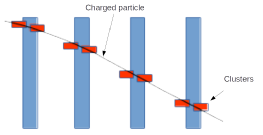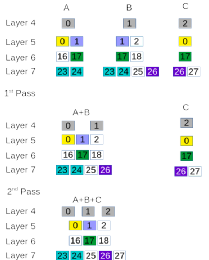Benjamin Kerridge
I am a 4nd year PhD student working on hardware tracking system for the ATLAS detector and searches for Long Lived Particles.

As a charged particle passes though the layers of a detector(blue) it leaves charge deposits(red) in the detector, which can be sensed and used to determine the path of the particle.
Hardware Tracking
A hardware tracking system searches the data from the detector to collect hits from the tracking detectors into tracks which represent a particle traveling through the detector. This is currently performed in software on a large farm of servers. When the LHC is upgraded to the High Luminosity LHC the number of collisions per bunch crossing (pile up) will increase significantly. This increase would require a significant increase in CPU resources to process events within the required timing constraints. An alternative is to deploy dedicated hardware capable of performing this tracking work and supplying the results to the CPU farm.
I work on developing a commodity FPGA based approach for achieving this, as an alternative to developing custom application specific integrated circuits (ASICs) as this approach could be delivered at lower cost.

The bundling process shown above combines tracks to produce a smaller set of bundles. Initially 3 possible tracks exist but the bundling process is able to reduce this to a single bundle by combining overlapping tracks.
Search Long-Lived Particles
Some Beyond Standard Model processes produce particles with lifetimes significantly longer Standard Model particles. This leads to these particles traveling further out into the detector before they decay.
Searching for these particles in the detector is complex due to the standard reconstruction algorithms are optimised for tracks starting close to the collision point. Observing such an LLP would be clear evidence of Beyond Standard Model physics.
Several models predict the existance of a long-lived scalar produced from the decay of a Higgs Boson. A search for such a scalar is being conducted at the ATLAS experiment by looking for the decay vertex of the long-lived scalar. As the particle is long lived the vertex produced when it decays would be displaced from the primary vertex (where the collisions occur) due to its extended lifetime, enabling it to travel further through the detector.
This search makes use of Large Radius Tracking to reconstruct the displaced tracks.
Large Radius Tracking
ATLAS is adding large radius tracking to the Trigger, this will help searches for LLPs, as the new tracking will enable the reconstruction of displaced tracks, such as those produced by LLP decays inside the detector. LRT in the Trigger consists of an optimised version of the existing trigger tracking algorithms.
New Triggers can use this new capability to trigger on events which contain displaced tracks, which can be produced by long lived particles.
Contact Details
Office: P448a
Email: Given on contact page
